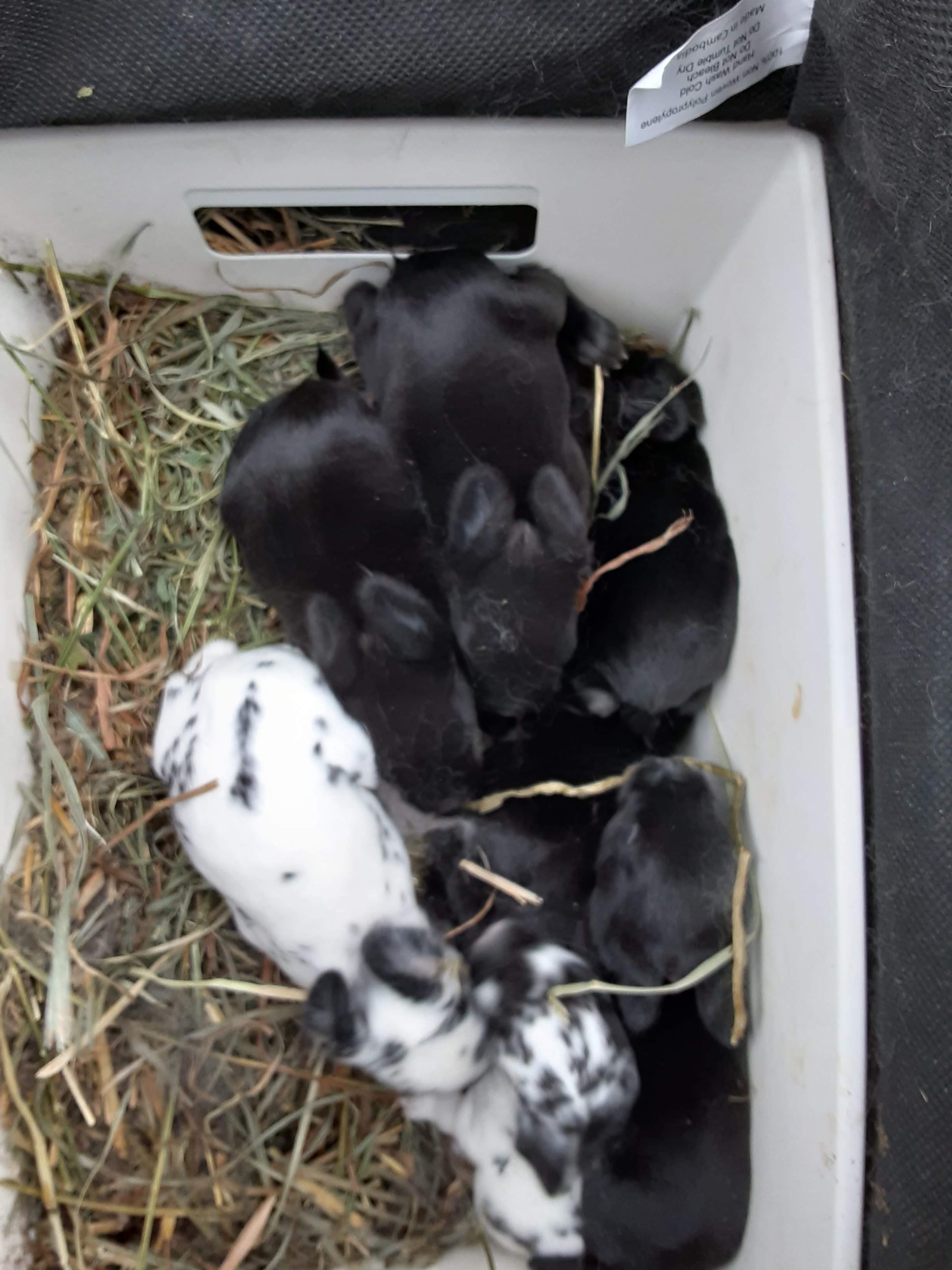I am often asked by people interested in getting started with rabbits what they should start with. My advice is for the person who wants to breed some backyard rabbits for family meat supply. Obviously if you want to win at shows, this is not the post for you.
I generally recommend anyone completely new to rabbits should start with two pairs of purebred rabbits with papers, that way there are two different bloodlines you can cross between. If you have children that are old enough to be involved in care and feeding, I recommend starting with two young bucks from two different litters, a young doe from a third litter, and a bred doe. This gives the children something to hold their interest and gets you some experience to see all aspects of raising rabbits to make sure it’s something you enjoy. If it’s not going to work out, for whatever reason, you can get out quickly before investing too much time and trouble.
An experienced doe is much less likely to have problems with her litter, and gives you a third bloodline to work with and several more young does you can choose to keep if you want to expand. Although a bred doe is much more expensive, it’s like getting 9 rabbits for the price of one, and her experience can be priceless if the owner has learning to do. If it is working out for you and you are enjoying the experience, you can keep the best buck and does from this litter to expand.
I have seen too many people get discouraged because they stated out with a trio of young rabbits, waited months and months for the young buck to figure out how to breed, having the young does kill or starve out their first litter, or have the buck die leaving them with no way to breed their does. It can be very difficult to find a replacement breeding age animal of quality. Also, it is always best to breed more than one doe at a time because then the litters can be evened up or bunnies fostered if something should happen to one of the does, or one refuses to be a good mother.
Starting out too big can often be an even more disastrous mistake. If someone is encouraging you to start with 2 bucks and 20 does RUN!!!! They are SCAMMERS, they know a new breeder will not be able to handle this and they will be able to swoop in and “rescue” this person needing to sell 22 young breeding age rabbits, 100’s of bunnies, and all the nice gently used equipment for a rock bottom price.
As far as how many you need, it will depend on how you want to feed them, how frequently you want to eat them, and how they will be cooked. Generally It seems half a rabbit per person, but many people say a rabbit will feed 4 people. If your making a soup or stew, or a lot of side dishes, obviously the meat will stretch further. If your BBQing it probably serves 2. I prefer to roast with bacon or fry so I feel one rabbit serves two. Also, my children are older, small kids will eat less.
Rabbit can be frozen for months, so if your producing more than you can use, you can just reduce your breeding of future litters until you balance your production with your consumption. Also, the market for meat rabbits is extremely strong, and you will never have trouble getting rid of “extra” rabbits if you have more than you can use.
I generally breed my does back when the litter is 5 weeks old. I return the doe to the bunnies cage once a day for the next three days to feed them (if she will) to ensure there is no milk gland trouble. I wean them completely by 6 weeks. I leave the doe(s) with the buck until about a week before they are due to deliver, at which time she gets her own cage and a nest box. If for some reason she didn’t settle with the initial breeding date, the buck will have re-bred her and your only missing out on two weeks. Additionally, there is no chance the breeders will get too fat when they are group housed. If you have a particularly crabby doe, this may not work. I cull does which do not play well with others!
I leave the weaned litter in their cage as long as I don’t need the cage, when I do, they are moved to a large grow out cage with other litters. I generally only feed hay to weaned litters. They grow more slowly but I don’t have problems with enteritis on hay. I butcher at 12 weeks or 5 pounds, whichever comes first, grow outs can be left together until this time, but must be separated soon thereafter, before they begin fighting. Feeding a higher energy diet, pellets, or grain will make your young rabbits grow much faster, but will increase the cost of raising them.
Breeding doe’s back sooner will result in more litters per year, but the quality of the litters generally declines. I like to keep my breeding rabbits in a thin, fit condition. The worst enemy of productivity is breeders getting too fat, which they will tend to do on full feed. My breeder cages will contain usually a pair. Breeding bucks should never be placed together, but sometimes 2-3 does with the buck is fine, assuming you put them in at the same time and you have a large enough cage.
I find this unconventional system minimizes cages required and keeps my adults calm and more social than always housing them alone. My bucks are more relaxed and not so aggressive with the does, and the does are more accepting of the bucks if they get to know each other better. This system isn’t for new breeders because you have to know your rabbits personalities to know if it will work.
In summary, the minimum I would recommend is a trio, two does and a buck. The buck should generally be older than the does, at least by a few weeks. Two pair, from three different litters is better if you have the cage space, as it gives you more options. I would not start with more than 4-5 as it can be overwhelming.



I have read so many articles about the blogger loves except this post is genuinely a nice paragraph, keep it up.
Valuable information. Lucky me I discovered your website by chance, and I’m shocked why this twist of
fate did not happened in advance! I bookmarked it.
Hmm it appears like your blog ate my first comment (it was extremely long) so I guess
I’ll just sum it up what I wrote and say, I’m thoroughly enjoying your blog.
I too am an aspiring blog writer but I’m still new to
the whole thing. Do you have any recommendations for inexperienced blog writers?
I’d genuinely appreciate it.
I was pretty pleased to discover this great site. I want to to thank you for ones time due to this fantastic read!! I definitely appreciated every part of it and I have you book marked to look at new stuff on your web site.
Cool, I’ve been looking for this one for a long time
_________________
ghd sports ipl live 2020 apps download